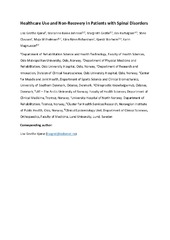Healthcare Use and Non-Recovery in Patients with Spinal Disorders
Permanent link
https://hdl.handle.net/10037/37936Date
2025-07-28Type
Journal articleTidsskriftartikkel
Peer reviewed
Author
Kjønø, Lise Grethe; Johnsen, Marianne Bakke; Grotle, Margreth; Hartvigsen, Jan; Clausen, Stine Haugaard; Wilhelmsen, Maja; Richardsen, Kåre Rønn; Magnusson, KarinAbstract
Methods - This observational registry-based cohort study includes 3745 patients aged 18–70 years (mean (SD) 46 (12) years, 59% women) from the Norwegian Neck and Back Registry (NNRR). We studied non-recovery 6 months after the specialist evaluation using the Global Perceived Effect (GPE) scale, defined as ‘slightly improved’, ‘unchanged’, ‘slightly worse’, ‘much worse’, or ‘worse than ever’. Using logistic regression, we examined the association between non-recovery and specialist-recommended healthcare (i.e., recommended follow-up in primary or secondary care) and actual healthcare use identified in national registries (visits to general practitioners, physical therapists, and chiropractors in primary care and outpatient and inpatient visits in secondary care).
Results - In total, 80% self-reported non-recovery at 6 months. Adherence to specialist-recommended healthcare was not associated with non-recovery (adjusted OR [aOR] 1.09, 95% CI 0.91–1.29). Highest odds for non-recovery were among patients using primary care alone (aOR 1.68, 95% CI 1.37–2.07) or no healthcare (aOR 1.81, 95% CI 1.44–2.27). Secondary care alone (aOR 0.75, 95% CI 0.59–0.96) or combined with primary care (aOR 0.49, 95% CI 0.41–0.59) was associated with recovery.
Conclusions - Our findings raise questions about the value of the specialist recommendations and also the content of healthcare services provided after a specialist evaluation.


 English
English norsk
norsk